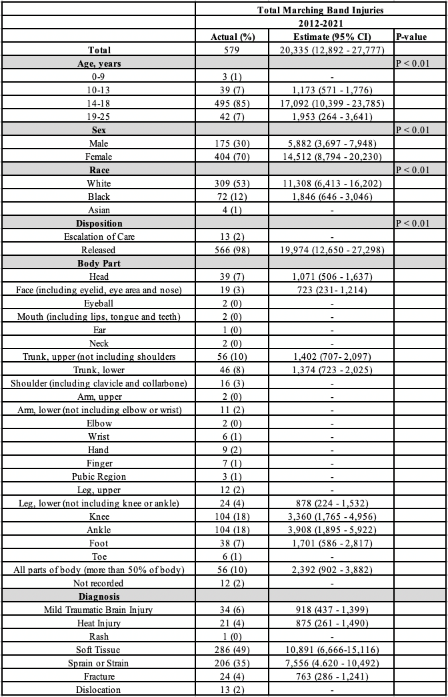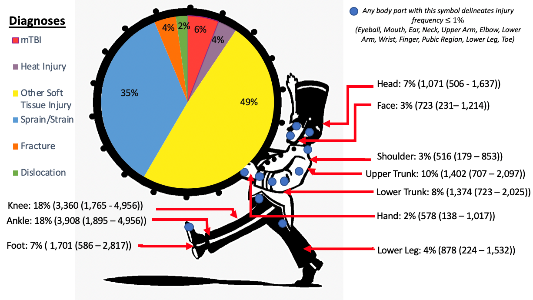Band members most often presented with ankle and knee injuries, but 6% of injuries are reported as mild head trauma.
Washington, D.C.—Marching band is a physically demanding task and performance art that can lead to injury similar to organized athletic activities. New research shows that 70% of marching band-related injuries reported to emergency departments over a 9-year period occurred in high school-age females, with most injuries to the ankles and knees.
The abstract, “Marching Band Injuries In Children Presenting to Emergency Departments in the United States, 2012-2021: A Trebling Tale,” will be presented during the 2023 AAP National Conference & Exhibition at the Walter E. Washington Convention Center.
“Like their instruments, band members must be in tune with their bodies,” said Capt. Jacob R. Coene, MD, MC, USAF, researcher. “Coaches and parents should be educated on the risk of soft tissue injury and mild traumatic brain injury to help keep their band members marching to the beat of the drum.”
Researchers reviewed an estimated 20,335 marching band injuries reported to emergency departments between 2012-2021, according to data provided by the National Electronic Injury Surveillance System. Eighty-five percent of marching band injuries occurred in those 14-18 years of age, and mild traumatic brain injury comprised 6% of all encounters. Half of the injuries occurred in the lower body, with ankles and knees most often at risk.
Recognizing the risks, the National Athletic Trainer Association issued recommendations to keep marching band members safe in 2017, according to researchers. States including Texas and Oklahoma have begun to require pre-participation physicals for marching band members. Unlike other organized athletics, such as American football, soccer and cheerleading there is a lack of evidence describing injury trends in marching band, according to the abstract authors.
Of all marching band injuries, 98% were treated and released from the emergency department.
The authors did not receive financial support for this research beyond the salary support provided for the co-authors by the United States Department of Defense.
Capt. Jacob R. Coene, MD, MC, USAF is scheduled to present the abstract, which is below, from 4:45 pm-5:45 pm ET Sunday, Oct. 22, 2023, during session H3021. To request an interview with the authors, contact Robert Whetstone at robert.a.whetstone.civ@health.mil.
Please note: only the abstract is being presented at the meeting. In some cases, the researcher may have more data available to share with media, or may be preparing a longer article for submission to a journal.
# # #
The American Academy of Pediatrics is an organization of 67,000 primary care pediatricians, pediatric medical subspecialists and pediatric surgical specialists dedicated to the health, safety and well-being of infants, children, adolescents and young adults. For more information, visit www.aap.org. Reporters can access the meeting program and other relevant meeting information through the AAP meeting website at http://www.aapexperience.org/
Abstract
Program Name: AAP National Conference & Exhibition
Submission Type: Section on Uniformed Services
Abstract Title: Marching Band Injuries In Children Presenting to Emergency Departments in the United States, 2012-2021: A Trebling Tale
Jacob Coene
San Antonio, TX, United States
Marching band is both a sport and a performance art. Organized athletics like American football, soccer and cheerleading all have well established epidemiological trends of injury-related morbidity, including stigmata from head trauma. By comparison, marching band, anecdotally leads to injury. Despite this potential for significant morbidity (e.g. mild traumatic brain injury or heat injury), little evidence exists on the epidemiology of marching band related injuries. Our study seeks to close this knowledge gap by characterizing marching band injuries which led to children being evaluated in Emergency Departments (ED) in the United States (US) from 2012-2021.
The National Electronic Injury Surveillance System (NEISS) database was queried using the product code 1200 (Sports or recreational activity, not elsewhere classified) to search for ED visits in the US. We applied a natural language processing search to evaluate the frequency of injuries in children 0-25 years of age from 2012-2021 whose narrative encounters included “marching” or “band”. Encounters were grouped based on age (10-13 [middle school], 14-18 [high school], 19-25 [college]), sex, and body part affected. Care patterns were investigated for diagnoses and escalation of care. All reported values are population national estimates generated from actual marching band-related injury encounters and were calculated using the NEISS-supplied weights and variance variables. Rao-Scott Chi-square was used for all categorical comparisons.
From 2012 to 2021 there were 20,335 estimated marching band injuries (MBI) from 579 actual cases (95% Confidence interval (95% CI) 12,892- 27,777) (Table 1). Of the MBI recorded, 84% occurred in those aged 14-18 years [i.e., high school] and 71% occurred in females, P < 0.01 and P < 0.01, respectively. The ankle (18%), knee (18%) and upper trunk (10%) were most injured (Table 1). Fifty percent of injuries occurred in the lower extremity. Major diagnoses in descending order of frequency were soft tissue injuries (10,891 (95% CI 6,666-10,492), mild traumatic brain injury (918 (95% CI 437-1,399), heat injury (875 95% CI 261-1,490), and fracture (763 (95% CI 286-1,241) (Figure 1). Of MBI, 98% did not require escalation of care, P < 0.01.
This is the first nationwide estimate of marching band injuries presenting to an ED. Marching band injuries were most likely to occur in high school aged females and soft tissue injuries of the lower extremity were the most common injury pattern observed. Sixteen percent of MBI were serious and included: mild traumatic brain injury, fractures, dislocations and or heat injury. Based on the injuries catalogued and the low rate of care escalation required, we theorize that a high proportion of these ED visits could likely be prevented. The injury patterns described provide an opportunity for targeted public health intervention by sports medicine teams.
Marching Band Injury Demographics and Injuries by Body Part and Diagnosis

Table 1 shows basic demographic information and injury breakdown by body part and diagnosis of children who presented to Emergency Departments in the United States from 2012-2021 for marching band injuries. Estimated frequencies involve population estimates with generation of 95% confidence intervals. A “-“ indicates when actual encounters were less than 20 and thus generated unreliable, wide confidence intervals.
Marching Band Injuries by Body Part and Diagnosis

Figure 1 illustrates the frequency of body parts injured and the frequency of diagnoses in children who presented to Emergency Departments in the United States from 2012-2021 for marching band injuries. Frequencies are shown as the percentage of the total actual injuries. National estimates of marching band injury by body part injured are illustrated with the frequency of injury to that location.